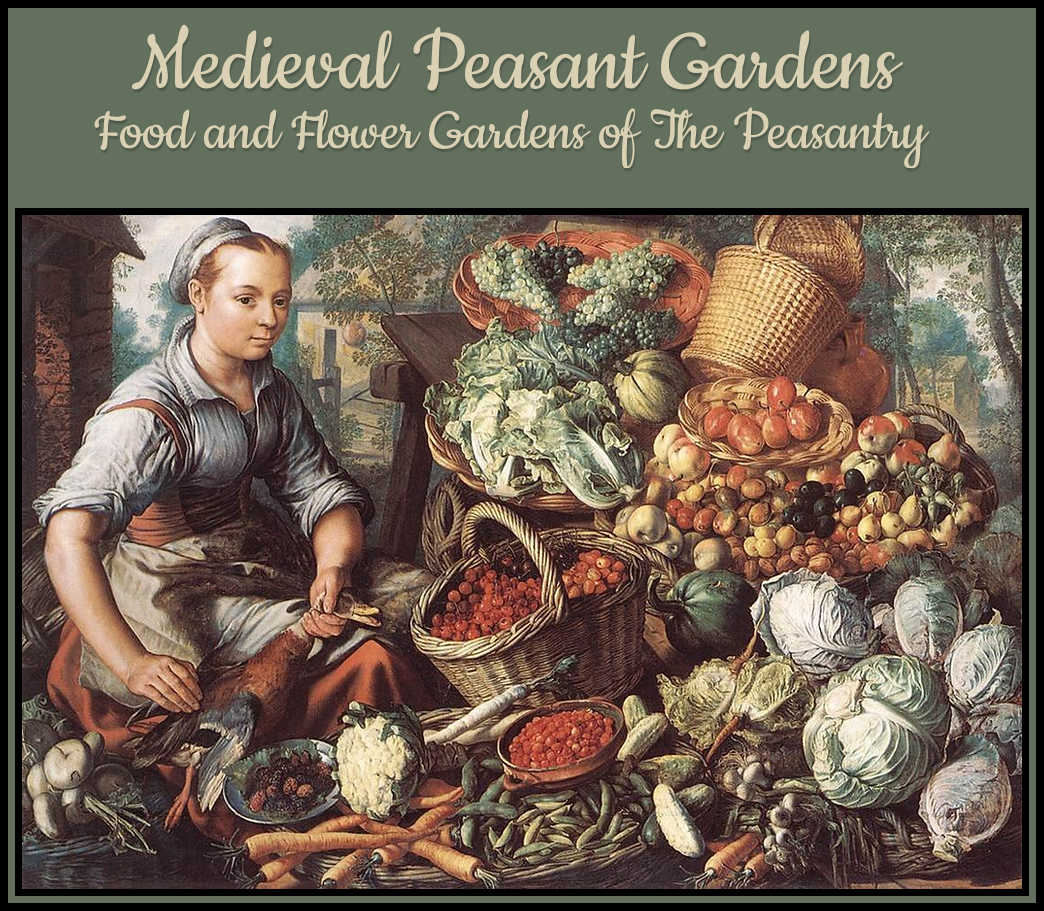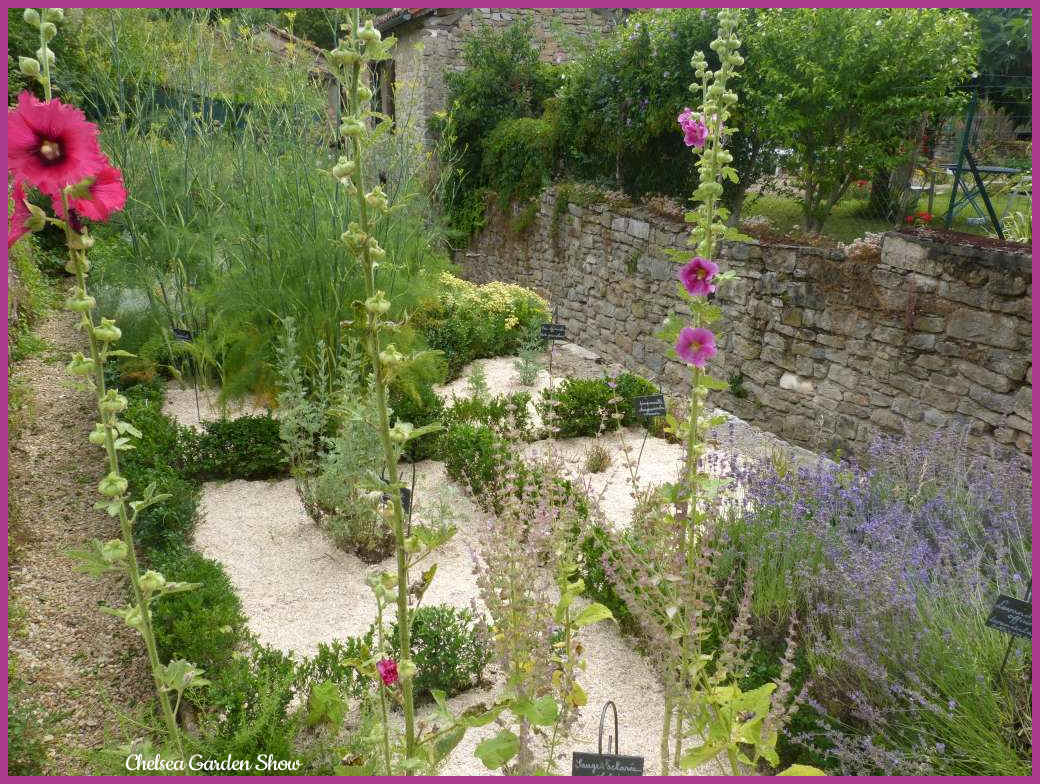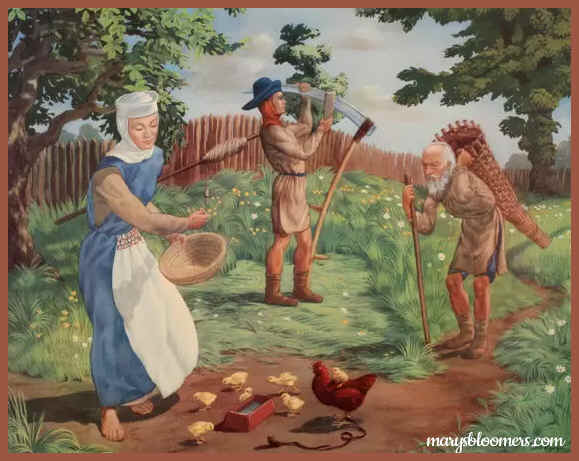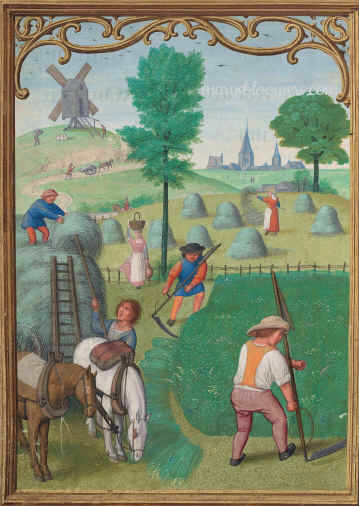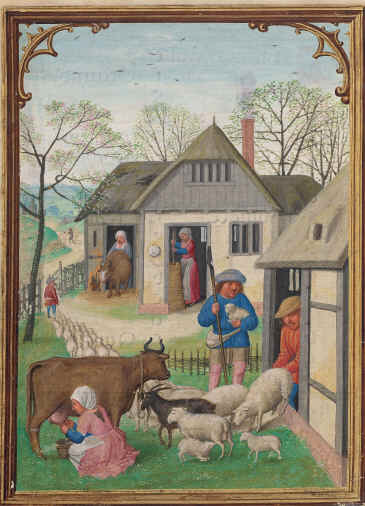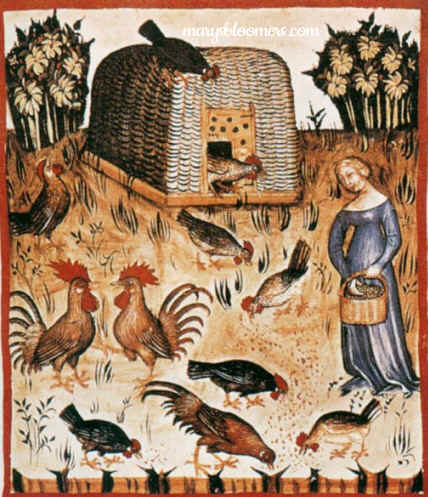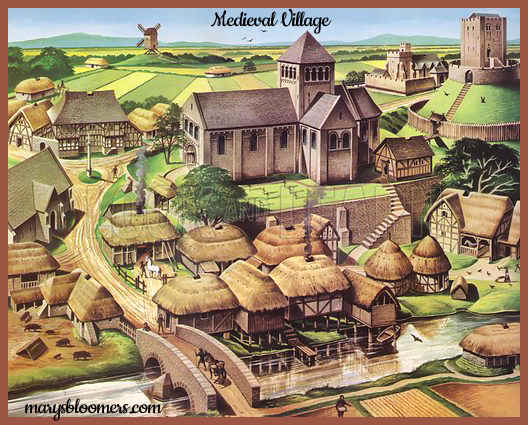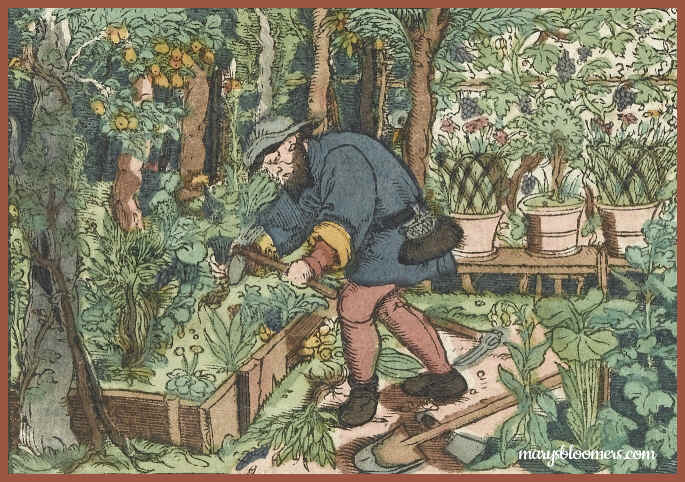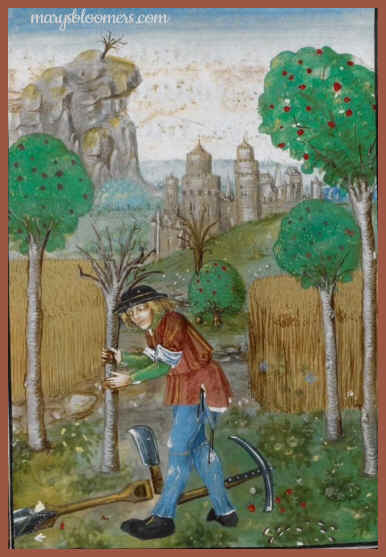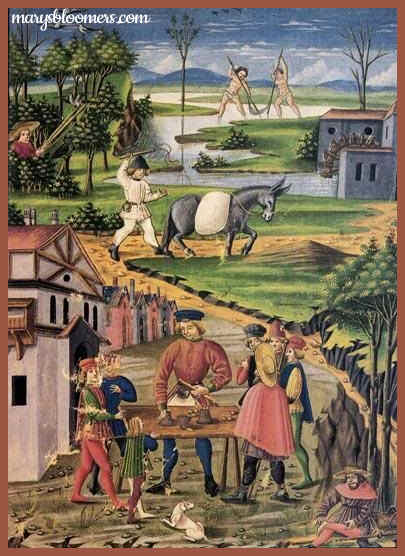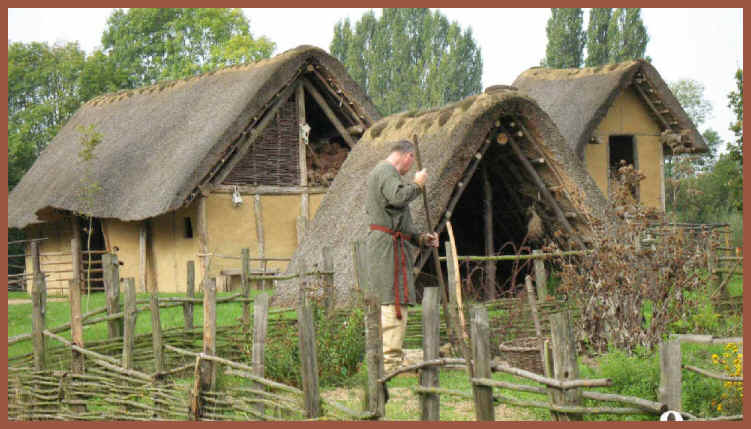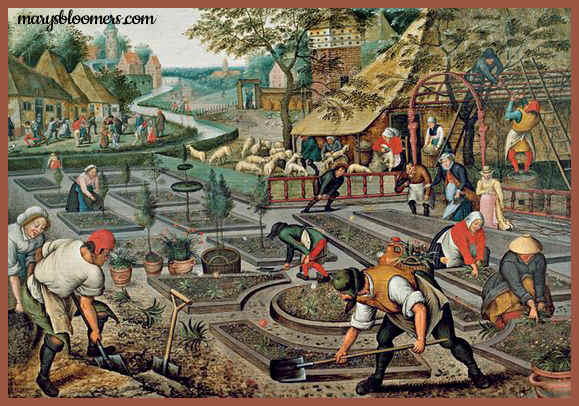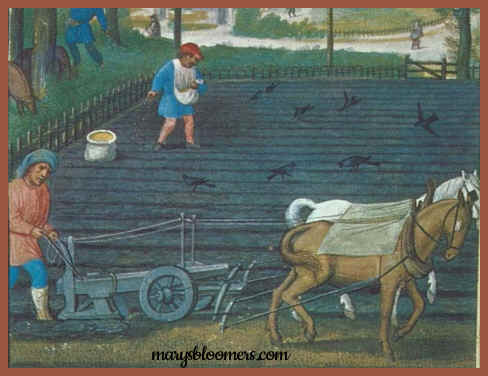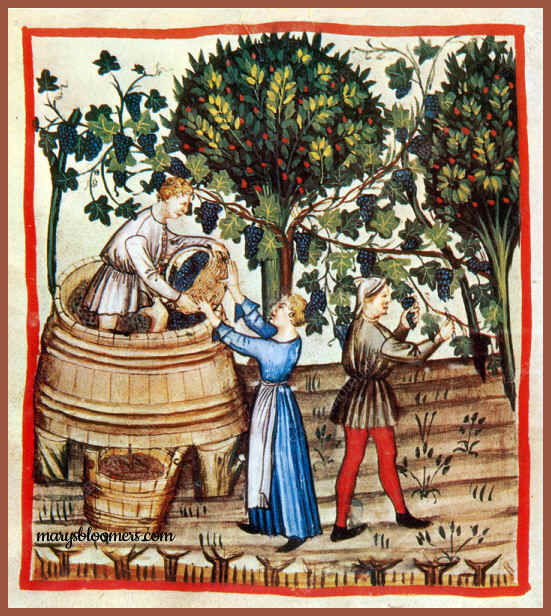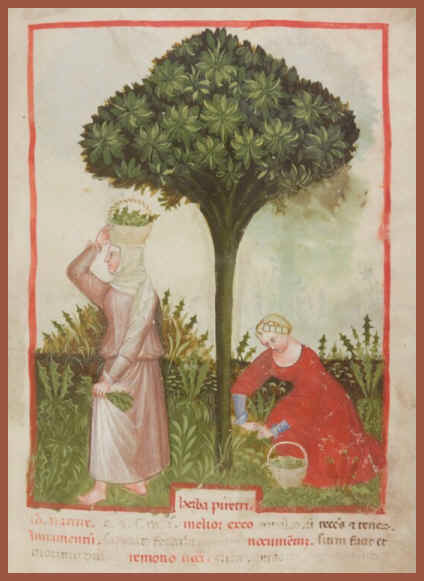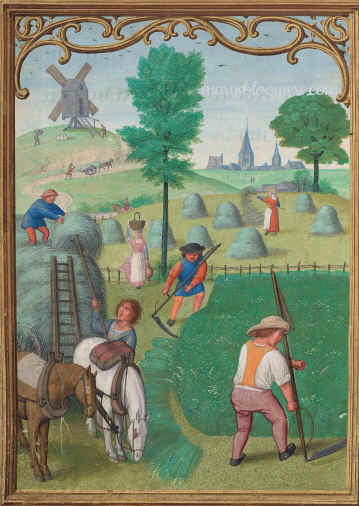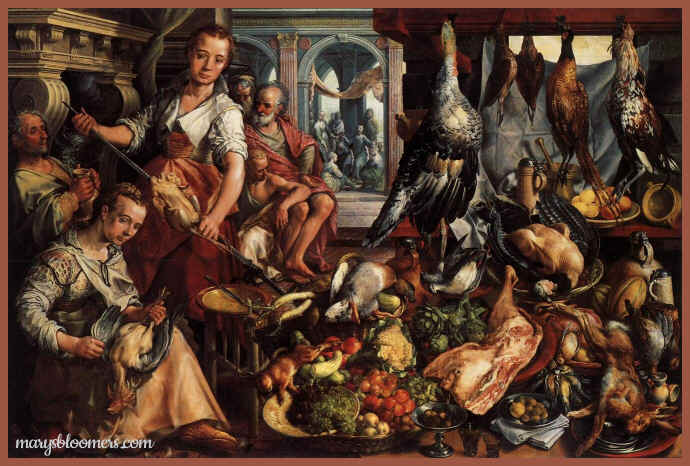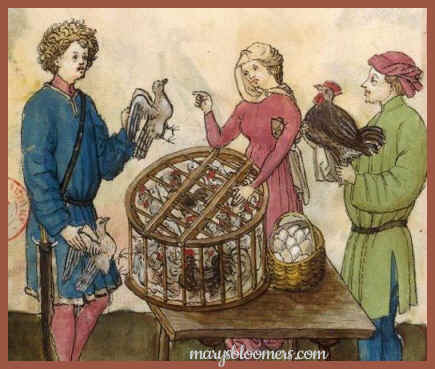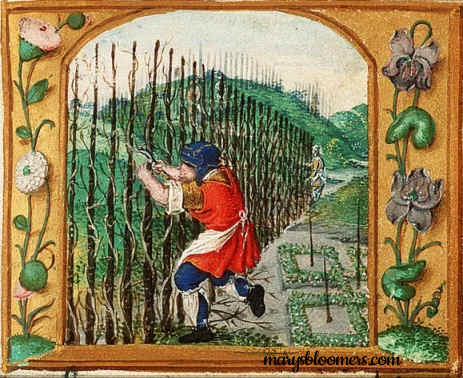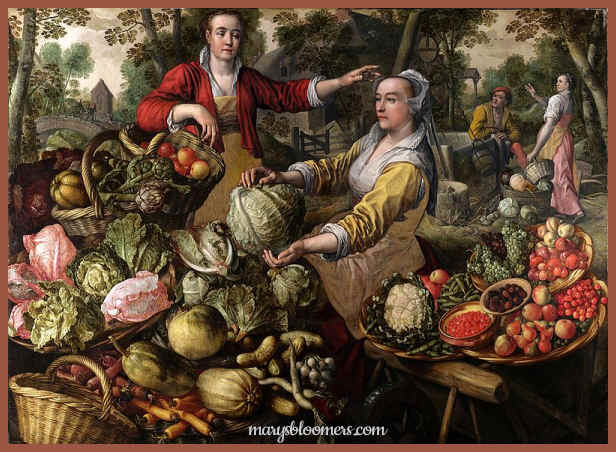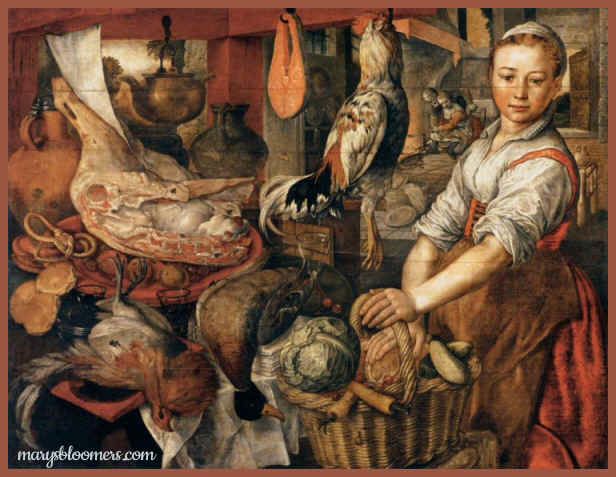| Garden History -
Peasant Vegetable and Flower Gardens- The dawn of the beloved Cottage
Garden in England
"Gardening is for
peasants" - That was the common refrain of the uber rich uber
snobby upper classes. Those rich folks worshipped the lawn. This
religion came in handy for those who were privileged and lazy, and did
nothing all day but admire the green expanse of nothingness outside
their mansions and castles, which they never tended themselves, crowing
about their croquet and tennis courts, and hosted big outdoor luncheons
upon them. If there was a garden somewhere out there, you can be assured
that the serfs and peasants took care of it. Sometimes, a Lady in the
manor had a love of growing things, and when all efforts to prevent her
from getting medieval soil under her manicured fingernails failed to
deter her, she could be found lovingly tending a garden, which was most
likely out of view of the rest of the upper class family and friends,
and was not to be seen from the street or from within, through the
windows. Thankfully, the medieval peasants and serfs didn't mind being
the inventors and curators of the beautifully disorganized and
beautifully scented English Cottage Garden.
Among all the horticultural
contributions made by the nation of impassioned gardeners, none may be
so influential and charming as the humble English
cottage garden. Appearing as if it sprung naturally from the
earth, the cottage garden
is an impressionistic work of art, and a riot of scent and color.
The
gardens of the middle and upper classes were formal, sometimes almost
flowerless, at other times filled with the most exotic annuals. It was
the peasant plots in Medieval England that often provided the only
refuge for plants that were virtually discarded by affluent, fickle
gardeners.
The
English cottage garden was free-form by nature, rejecting straight lines
and neat beds, it employs certain elements that have become its
hallmarks: fragrant roses over an arched doorway, the scent of
rosemary outside the kitchen window, the seemingly wild tangle of
poppies and hollyhocks that spill over onto well-worn old stone paths.
Today,
the charming ''artlessness'' of the English garden is often carefully
planned by landscape architects. But the rustics who first planted them
had no intention of creating an international fashion in gardening. They
simply constructed the most traditional shelter they could afford, and
surrounded it with a wide range of hardy perennials that could survive
the English winters.
Medieval
Peasantry
It wasn't called The Dark Ages for nothing.
Serfs were peasant farmers who were neither fully free, nor were theyslaves.
They could not leave the village, sell an ox, or marry without the lord
of the manor's permissions. The peasants had a little more freedom but
still rarely left their local area. According to the law, serfs did not
belong to themselves. They and all their belongings, their house,
clothes, and even their food, were owned by the lord of the manor. They
were bound to work for their lord, who allowed them to farm their own
piece of land in return. Their lives were ones of constant toil. Most
struggled to produce enough food for their own families as well as
fulfilling their duties to the lord of the manor. Life expectancy of the
serfs was 27 years.
For centuries, serfs (real meaning:
slaves) had worked the land belonging to great lords. Suddenly, the
Black Death of 1349 nearly wiped out the population. In England, more
than one-third of the population died, and only a tiny proportion of the
rural labor force survived. The great imbalance of supply and demand for
manual labor gave the serfs an opportunity to put a premium on their
services. Many serfs were allowed to take over vacant land and
they became remarkably liberated as tenant farmers.
Peasant
Practicalities
Soon afterwards, gardens began to appear around their cottages of stone
and wood and thatch. These were used at first for practical plantings:
vegetables and herbs. Peasants rarely had or ate meat; so plants
provided most of their nourishment. Herbs were not only an inexpensive
source of seasoning, but also an important source of medicine.
Peasants
might stop along the lane on their way home from work and dig up a
wildflower for their home gardens. This marked the beginnings of the
cottage wildflower garden... Hybrids were created by mere chance. Botanical
oddities were revered as treasures, pried loose from soil and between
stones by hand, tucked into a pocket, and carried home to be set among
the vegetables and herbs. Little by little, the peasant garden became a
place of delightful disorder, a green cabbage growing with cabbage
roses, daffodils surrounded by onions and marigolds, and so on.
Cottage
Gardens
An
enclosed yard with a stone wall or wood fence separated the garden from
the main village road. A straight path led from this lane to the front
door. This walk was edged with herbs, and behind them were
vegetables-arranged for easy access. A few fruit trees and perhaps a
beehive completed the basic plan.
As
the cottage garden became more and more sophisticated, vegetables and
fruit were restricted to a separate site. In many instances, tall
hollyhocks, foxgloves and delphinium backed the flower borders and
shielded the homely vegetable plots from view from the sitting-room
windows of the cottage.
By
the 16th Century, increased commerce overseas helped to introduce many
new flowers to English soil. Huguenots, fleeing persecution in France,
brought many flowers, such as auricula (a species of primrose) and
dogtooth violet (Erythronium).
From
the early 17th Century on, many plants began to arrive from the
Americas. A gardener named John Tradescant introduced to England the
spiderwort (Tradescantia) and many blue asters. The wilds of Canada were
the source of several goldenrods and rudbeckia (blackeyed susan).
These valuable introductions greatly extended the growing season of the
English garden.
By
the 18th Century, the English cottage gardens contrasted greatly with
the meager gardens of the French peasants, which consisted almost
entirely of apples and cabbages.
In
1500 there were perhaps 200 kinds of cultivated plants in England. By
1850 the varieties had reached 18,000.
Nearly all garden flowers of today were the glories of these fertile
years of the cottage garden. The triumphant naturalized landscapes so
fashionable today are the offspring of those rustic little plots of
cabbages, herbs and flowers invented by English peasants.
These
rustic landscapes were so slightly appreciated in industrial Britain
that they barely survived the 19th Century. The old-fashioned hardy
perennials of the cottage garden were fast losing popularity with
townspeople who wanted to imitate the upper classes and plant the most
flamboyant and gaudy annuals.
Those
who had profited greatly from the Industrial Revolution wanted broad,
expansive lawns around their homes, which they felt gave their estates a
grandness representing wealth and refinement. The last thing the rich
wanted in 19th Century England was a peasant`s garden.
In
1889. a partnership set a style that became known as the ''Surrey
School,'' in essence, an approach to landscaping that emphasized
harmonious arrangement of informal gardens within formal structures-the
very epitome of the gardening trends most respected today.
Plants
Grown In The Peasant Cottager's Garden
Essentially there were 4 types of
plant in a medieval peasant garden. Vegetables, herbs, flowers and
fruit. Peasants grew all the herbs we know today, plus many more since
forgotten. Some flowers were grown for ornamental use, others for
salads and medicinal potions. The most common fruit was apples, pears,
quince, rhubarb and elderberry.
An example of a peasant food
garden design is the French Potager
Garden (kitchen vegetable garden). Download the design
and layout, free.
Authentic gardens of the yeoman
cottager would have included a beehive and livestock, and frequently a
pig and sty, along with a well. The peasant cottager of medieval times
was more interested in meat than flowers, with herbs grown for medicinal
use and cooking, rather than for their beauty. By Elizabethan times,
there was more prosperity, and more room to grow flowers. Even the early
cottage garden flowers typically had their practical use—violets were
spread on the floor (for their pleasant scent and keeping out vermin);
calendulas and primroses were both attractive and used in cooking.
Others, such as sweet william and hollyhocks, were grown entirely for
their beauty.
Until the late 19th century, cottage
gardens mainly grew vegetables for household consumption. Typically half
the garden would be used for cultivating potatoes and half for a mix of
other vegetables plus some culinary and medicinal herbs.
John Claudius Loudon wrote
extensively on cottage gardens in his book An Encyclopædia of
Gardening (1822) and in Gardener's Magazine from 1826. In
1838 he wrote "I seldom observe any thing in a cottage garden but
potatoes, cabbages, beans, and French beans; in a few instances onions
and parsneps, and very seldom a few peas". An 1865 issue of The
Farmer's Magazine noted that in "Ireland and much of the
Highlands of Scotland, potatoes are the only thing grown in the
cottage-garden".
A few plants that were historically grown and wildcrafted by the
medieval under-classes for food, ornamental purposes, medicine, and magic
- Angelica
- Blessed Thistle
- Catmint
- Chickweed
- Chicory
- Chives
- Comfrey
- Cowslip
- Dill
- Foxglove
- Fennel
- Good King Henry
- Horehound
- Lady's Mantle
|
- Lemon Balm
- Mints
- Mugwort
- Mullein
- Nettles
- Oregano
- Poppies
- Soapwort
- Sorrel
- Tansy
- Thyme
- Vervain
- Wormwood
- Yarrow
|
Gardens
of The Medieval Peasantry
| The
"kitchen garden" was where some vegetables and herbs
might be grown for food, as well as for fuel or as habitat for
animals which were hunted. The "physic garden" would
be planted with various medicinal herbs. The "aesthetic
garden" was developed largely for ornament and pleasure.
Many times a gardener would use a plot of ground for a mixture
of the recreational, aesthetic, and practical purposes. Flowers
in a garden with their fragrance would be both practical and
aesthetic. Medieval gardens were frequently enclosed; the
fragrances of flowers and herbs were confined and concentrated. |
The
tasks of the peasant in tending a garden
Spring
Spring was the time to sow seeds and nurture plants and bulbs
from the previous year. There were no chemical fertilizers, so nitrogen
had to be found growing naturally, then used as a tilled-in amendment.
Usually, this took the form of manure. "Muck spreading",
as it’s commonly known in England, dates back at least 8,000 years.
Summer
As summer approached, the peasant garden was at its best.
Flowers were blooming, herbs, fruit and vegetables all thriving. Peasant
gardeners had to ensure the soil was not too dry, and most peasant
gardens had their own well. If not, they had were usually close a stream
or river because water was a prime factor in good garden
‘housekeeping’
Autumn and Winter
Autumn was the time for harvesting. Tasks were varied, and involved
picking fruit from trees, gathering herbs and flowers, and uprooting
garden root vegetables. As winter approached, peasants spent much of
their time preserving fruits and vegetables to make storable sources of
nutrition.
The
Peasant’s Diet
The
Peasant's Diet is actually considered a very healthy diet. Eating meat
was a rarity, fish,
poultry, vegetables, grains, dried berries and fruits comprised the
majority of their food intake.
Below
is some 16th century artwork depicting peasant diets and their kitchens.
- Since they carried out heavy work
and were subjected to severe weather conditions during the winter
period, medieval peasants needed to consume many calories a day.
- Cereals were the most widely-used
food, especially for making bread, which was generally made with
wheat flour (however, most peasants made bread with rye flour).
- Wheat and other cereal flour,
such as barley, millet and oats, was also used in the preparation of
soups, ravioli (stuffed with meat) and, rarely, sweet and savoury
pies.
- Although of poor quality, wine
was always present on the tables of peasants.
- It was rare for peasants to eat
meat, since it was often only obtained through hunting, and hunting
was reserved for the noble classes.
- An alternative source of protein
to meat was eggs and fish (especially in mountainous areas rich in
streams).
- Milk was used primarily for the
preparation of cheese and butter: only occasionally was it used as a
drink.
- Butter was a very rare product
for peasants and was found mainly in the diets of the nobility,
unless peasants owned livestock.
- Fresh fruit was not popular due
to storage difficulties, but food such as walnuts, chestnuts and
hazelnuts was easily found in the woods and was easy to preserve for
a long time.
- Although cereals represented the
basis of every meal, vegetables such as cabbage, beets, onions,
garlic and carrots were also very common foods, and were grown in
peasant gardens..
- Many of these vegetables were
consumed on a daily basis by farmers and manual workers and,
therefore, were considered less prestigious foods than meat. Nobles
and richfolk avoided these foods.
Foraging
was also important, and mushrooms, herbs, and other root vegetables were
commonly used in making "pottage",
a type of stew made in a pot. Pea pottage was the main choice
for supper and would be slow-cooked over a fire. It was a very hearty
and healthy meal, usually containing peas, onions and herbs found in the
wild, or grown in their gardens. Spices were far too expensive and out
of reach for most peasants, so instead, many got creative with the herbs
they could grow or find.
Among
the useful garden flowers were those of the artemisia family.
Southernwood’s hair-like leaves were used to relieve fevers and wounds
and, when dried, it was valued for its aroma. The ability to purge a
person of worms and poisons was attributed to wormwood, which was also
respected as a cure for constipation and stomach discomfort, and as a
flea repellent (as was pennyroyal).
Wormwood has a bitter taste, unlike mugwort, which was used to flavor
drinks.
The tansy flower was an insect repellent. The entire plant is aromatic
and bitter to the taste, and all parts of the plant were used in
cooking.
Another useful flower was the marigold, which was used both as a
medicine, against stings and pestilence, and in cooking, as a bitter
spice. Marigolds were well-known insect repellents in the garden.
The blue iris had many uses. The iris root made a good ink and, when
dried, had a sweet smell. Iris leaves could be used in making mats,
patching thatched roofs, or for rushes used in covering floors. The iris
also made a dark blue juice that was used for spot removing, as a salve
for teeth and gums, and as an ingredient in a dye for cloth.
Periwinkle
garlands and wreaths could easily be woven because of the long, supple
stems, and the plant grew low, making it a useful and attractive ground
cover. Medieval English liked flowery meadows, or meads, of
scythe-mown grass, fragrant herbs, and flowers like violets, daisies,
primroses, and periwinkles, to walk, dance, and lie among the visual
beauty and surrounding aromas. Violets were popular, and symbolic of
humility, freshness, purity, and innocence. Dishes made were sometimes
garnished with violets. The petals were used as an emetic and purgative,
and the oil could scent a bath or soothe the skin. Like periwinkles,
daisies were made into garlands and crowns, and were included in
gardens.
The primrose could be made into wine. The leaves were used on wounds to
ease pain and on the skin to avoid blemishes, and they were eaten to
ease muscle aches. The petals were also eaten for pain relief, cooked
into tansy cakes and pottages, and floated in comforting baths.
The
gillyflower, ancestor of the carnation, was respected for its usefulness
and attractiveness. It was used in cooking as a spice for its aroma and
clove-like taste, and was used to cover the bitter taste of some
medicines as well as in wine and ale.
The seeds of the peony were used in flavoring meat, or were eaten raw to
warm the taste-buds and stabilize the temperament. They were also drunk
in hot wine and ale before retiring at night to avoid disturbing
dreams.
Sweet woodruff was frequently used for garlands, with a sweet fragrance
and white color, and was also added to drinks. The leaves were so
scented that they were known as “sweetgrass,” and were strewn when
dried on floors and packed with clothes as a freshener.
The
white rose was a garden favorite.
Red roses were also found in
England
throughout the Medieval period. Roses were
used as symbols of the Holy Spirit, and were scattered in churches.
Along with these cultivated roses there was the native wild rose, known
as the sweet briar or eglantine. It has a lovely fragrance, is a good
climber for walls and fences, and was used in the making of mead and
various medicines. The flowers of Medieval cultivated roses were
smaller, more open, and more fragile than today's roses, and they had a
more delicate fragrance. The Medieval rose plants were more like
rambling bushes, and the thorns were longer and more plentiful. When the
rose petals were dried and powdered they had the most powerful
fragrance. The petals of the red rose were used in the making of rose
water, rose oil, rose preserves, garnishes, and rose sugar.
The
lily was a special devotional flower, associated with the Virgin
Mary.
The white petals represented her purity, and the golden anthers the
light of her soul. The lily was an ancient fertility symbol. The lily
represented purity, innocent beauty, and chastity, a parallel for the
virgin birth of Christ. The central setting of The Song of Songs
in the Old Testament is that of a garden. Therefore the example of
sensual literature most widely known to Medieval people took place in a
garden.
Traditional Medieval Pottage Stew
This sounds like something i would make in a crockpot as
a slow-cooked stew or soup for cold winter days.
| "Pottage" Stew, from Old French pottage 'food
cooked in a pot') is a term for a thick soup or stew made by
boiling vegetables, grains, and, if available, meat or fish. It
was a staple food for many centuries. Pottage consistently
remained a staple of the poor's diet throughout most of 9th to
17th-century Europe. It was meant to keep a peasant or serf
working and healthy.
Pottage was typically slow-boiled for several
hours until the entire mixture took on a homogeneous texture and
flavor; this was intended to break down complex starches and to
ensure the food was safe for consumption. It was usually served
with bread, when available.
Pottage ordinarily consisted of various
ingredients, mostly, if not all, vegetables that were easily
available to serfs and peasants, and could be kept over the fire
for a period of days, during which time some of it could be
eaten, and then more ingredients added. The result was a dish
that was constantly changing in flavor. Today, we would consider
Pottage to be a healthy part of our fast-food-addicted diets.
Very little meat or fats appeared on a peasant's plate.
The earliest known cookery manuscript in the
English language, written by the court chefs of King Richard II
in 1390, contains several pottage recipes including one made
from cabbage, ham, onions and leeks. During the Tudor period, a
good many English peasants' diets consisted almost solely of pottage.
Some peasants ate self-cultivated vegetables like cabbages and
carrots and a few were able to supplement this from fruit
gardens with fruit trees nearby.
Some pottages that were typical of medieval
cuisine were jelly (animal flesh or fish in aspic),
mawmenny (a thickened stew of capon or similar fowl), and pears
in syrup. There were also many kinds of pottages made of
thickened liquids (such as milk and almond milk) with mashed
flowers or mashed or strained fruit.
Typical Pottage Recipe -Add game meats,
poultry, bits of pork, beef or fish, when available. The
main components were vegetables like peas, carrots, potatoes,
cabbage, spinach, turnips, parsnips and rutabagas, and a variety
of grains in a milk or broth “stew”. Meat, cheeses or eggs
could be added. Herbs were used to give flavor. Pottage was a
healthy and hearty recipe that filled you up, kept you
warm and your energy levels high.
Suggested
Ingredients:
1
¾ c. chopped vegetables of your choice. Include root
vegetables.
“knob” of butter (2-3 tablespoons)
¼ c. uncooked oats
Fresh, chopped
garden herbs and seasonings of any type
Onion, shallots or scallions
1 pint of vegetable broth or stock
Variation:
include small, cubed bits of game, ham, beef, chicken or fish
Method:
1.
Melt butter in a cauldron or dutch oven, and fry the vegetables
to soften them.
2.
Add the chopped herbs and oats and stir gently.
3.
Carefully pour in the stock. Cover with a lid and simmer slowly,
stirring from time to time, for several hours.
4.
Once the oats have thickened the sauce, and the vegetables are
softened, the pottage is ready.
To
serve enough for a family, double or triple the amount of
ingredients. Serve with hot, crusty bread, and use the bread to
sop up the juices.
To
use the traditional long-cooking method over a period of days -
serve some of the pottage when ready, and add more ingredients
to the pot. Simmer again with more broth and oats if needed,
rotating the added ingredients as the stew is eaten. Keep the
pottage consistently hot until the last serving. |
Article ©2021 marysbloomers.com
Compilation and adaptation
Article Compiled using these Sources
The Great Courses Daily
Wikipedia
Wikimedia Commons
Artwork in the Public Domain
Original Manuscripts from The Book of Hours
Chicago Tribune 1987
Historic Medieval Illuminated Manuscripts
Medieval Recipes
Roots Web - Society in King Egbert's Time
The
Medieval Castle Gardens-->
Monastery
and Cloister Gardens-->
English Cottage Flower Garden--->
To
learn about American Slave Gardens, click
here.
Design, graphics,
articles and
photos ©2008-2021 marysbloomers.com™
All rights reserved.
|
